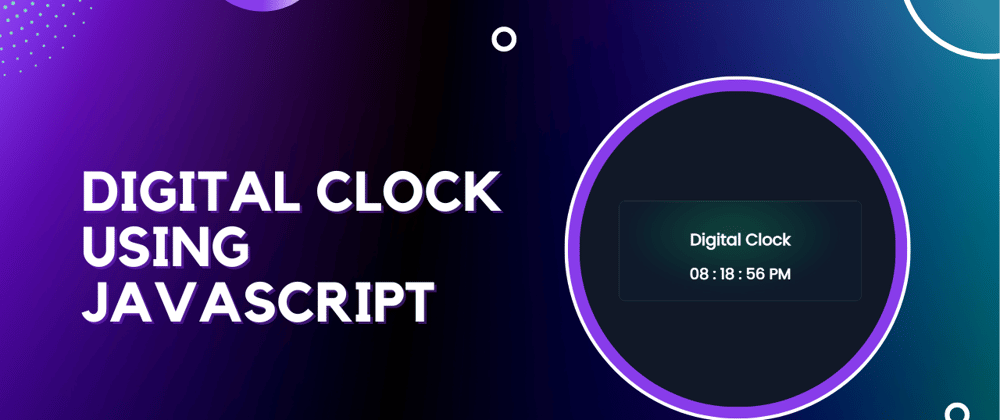Hello Guys! In this blog, I'm going to explain to you how to make a digital clock using javascript. You can use this project on your website to show the time to your users. I know users can see the time on their systems but you can use this project to show different time zones. This will be a step-by-step guide including HTML and CSS. Let's get started 🚀.
Let's cover HTML Part
We use HTML to make the skeleton of a website. HTML is a markup language.
Now let's import the font awesome CDN in our HTML <head> tag. fontawesome is a library that is used for icons in a website.
<!-- Font Awesome Icons -->
<link rel="stylesheet" href="https://cdnjs.cloudflare.com/ajax/libs/font-awesome/5.15.1/css/all.min.css"
integrity="sha512-+4zCK9k+qNFUR5X+cKL9EIR+ZOhtIloNl9GIKS57V1MyNsYpYcUrUeQc9vNfzsWfV28IaLL3i96P9sdNyeRssA==" crossorigin="anonymous" />
Now let's import the fonts using Google Fonts API. Below is the code for Poppins Font. Paste the below code in <head> tag.
<!-- Google Fonts -->
<link rel="preconnect" href="https://fonts.googleapis.com">
<link rel="preconnect" href="https://fonts.gstatic.com" crossorigin>
<link href="https://fonts.googleapis.com/css2?family=Poppins&display=swap" rel="stylesheet">
In the below HTML code, we have created a container that has a card div and inside the card div, we have a time display div with id 'clockDisplay' and onload attribute to invoke showTime() function on website loads.
<div class="container">
<div class="card">
<h1 id="day">Digital Clock</h1>
<div id="clockDisplay" class="clock" onload="showTime()"></div>
</div>
</div>
Here is the final HTML code
<!doctype html>
<html lang="en">
<head>
<!-- Required meta tags -->
<meta charset="utf-8">
<meta name="viewport" content="width=device-width, initial-scale=1">
<!-- Font Awesome Icons -->
<link rel="stylesheet" href="https://cdnjs.cloudflare.com/ajax/libs/font-awesome/5.15.1/css/all.min.css"
integrity="sha512-+4zCK9k+qNFUR5X+cKL9EIR+ZOhtIloNl9GIKS57V1MyNsYpYcUrUeQc9vNfzsWfV28IaLL3i96P9sdNyeRssA=="
crossorigin="anonymous" />
<!-- Google Fonts -->
<link rel="preconnect" href="https://fonts.googleapis.com">
<link rel="preconnect" href="https://fonts.gstatic.com" crossorigin>
<link href="https://fonts.googleapis.com/css2?family=Poppins&display=swap" rel="stylesheet">
<title>Digital Clock using JavaScript - @code.scientist x @codingtorque</title>
</head>
<body>
<div class="container">
<div class="card">
<h1 id="day">Digital Clock</h1>
<div id="clockDisplay" class="clock" onload="showTime()"></div>
</div>
</div>
</body>
</html>
Output Till Now
Let's understand CSS part
In the below CSS code.
- We declare a * selectors for the font Poppins that we have imported in our head tag.
- Next, we declare a body selector which consists of styles for dark mode and aligns all elements in the body to the center.
- Next, we have a container and card with glassmorphism effect. I have created this Glassmorphic effect using Glass UI.
* {
font-family: 'Poppins', sans-serif;
}
body {
background-color: #111827;
color: white;
display: flex;
align-items: center;
justify-content: center;
}
.container {
border-radius: 20px;
width: 30rem;
background-color: #111927;
background-image:
radial-gradient(at 47% 33%, hsl(162.00, 77%, 40%) 0, transparent 59%),
radial-gradient(at 82% 65%, hsl(218.00, 39%, 11%) 0, transparent 55%);
}
.card {
display: flex;
flex-direction: column;
align-items: center;
padding: 30px 80px;
backdrop-filter: blur(16px) saturate(180%);
-webkit-backdrop-filter: blur(16px) saturate(180%);
background-color: rgba(17, 25, 40, 0.75);
border-radius: 12px;
border: 1px solid rgba(255, 255, 255, 0.125);
}
.clock {
font-size: 30px;
font-weight: bold;
}
Output Till Now
Finally a JavaScript part
function showTime() {
let date = new Date();
let h = date.getHours(); // 0 - 23
let m = date.getMinutes(); // 0 - 59
let s = date.getSeconds(); // 0 - 59
let session = "AM";
let day = date.getDay();
if (h == 0) {
h = 12;
}
if (h > 12) {
h = h - 12;
session = "PM";
}
h = (h < 10) ? "0" + h : h;
m = (m < 10) ? "0" + m : m;
s = (s < 10) ? "0" + s : s;
let time = h + " : " + m + " : " + s + " " + session;
document.getElementById("clockDisplay").innerText = time;
document.getElementById("clockDisplay").textContent = time;
setTimeout(showTime, 1000);
}
showTime();








Top comments (0)